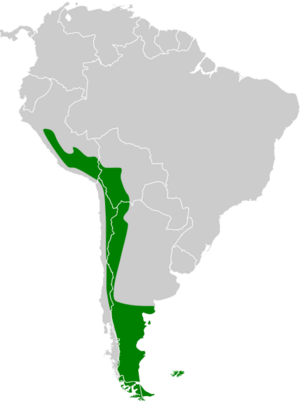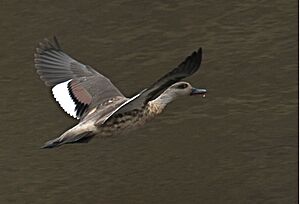Crested duck facts for kids
Quick facts for kids Crested duck |
|
|---|---|
 |
|
| Conservation status | |
| Scientific classification | |
| Genus: |
Lophonetta
|
| Species: |
specularioides
|
| Subspecies | |
|
|
 |
|
| Synonyms | |
|
Anas specularioides |
|
The crested duck is a special type of duck that lives in South America. You might also hear it called the South American crested duck. Its scientific name is Lophonetta specularioides. This duck is the only species in its group, called a monotypic genus (meaning a genus with only one species), which is named Lophonetta.
Scientists sometimes used to put it in the Anas group, which includes many common ducks. However, the crested duck is part of a unique group of ducks from South America. This group separated very early in the history of dabbling ducks. Dabbling ducks are ducks that feed by tipping their bodies forward in the water, rather than diving completely.
There are two main types, or subspecies, of the crested duck:
- L. specularioides alticola, known as the Andean crested duck.
- L. specularioides specularioides, known as the Patagonian crested duck or southern crested duck. This type lives in places like the Falkland Islands, Chile, and Argentina.
Contents
What Does a Crested Duck Look Like?
Crested ducks are medium-sized birds. An adult male can weigh a bit over one kilogram (about 2.2 pounds). Both male and female ducks look quite similar. Males usually have a slightly bigger crest of feathers on their heads than females.
Their feathers on the back and shoulders are dark brown. These feathers have lighter centers, which makes them look spotty or mottled. The belly, sides, and feathers under the tail are light gray. Their tail is long and black, which is a unique feature.
The upper part of their wings is gray-brown to light brown. The secondary feathers (a specific set of wing feathers) have a shiny, iridescent look. This shimmer can appear coppery or greenish. Behind this shiny part, there is a wide black band, which has a thin white edge. Young ducks look similar to adults but do not have a crest. Their faces are light brown, and their bellies are paler than adult ducks.
Where Do Crested Ducks Live?
Crested ducks are found only in South America. The two subspecies live in different areas, especially at different heights in the Andes mountains.
Andean Crested Duck Habitat
The Lophonetta s. alticola subspecies lives at very high elevations. You can find them from 2,500 to 4,800 meters (about 8,200 to 15,700 feet) above sea level. Their range stretches from Peru down to central Chile.
Southern Crested Duck Habitat
The Lophonetta s. specularioides subspecies lives at lower elevations. They are found below 1,500 meters (about 4,900 feet) in the southern Andes. This includes areas near Patagonia and the Falkland Islands. Sometimes, both subspecies can be found in the middle, in places like Mendoza, Argentina, and Talca, Chile.
Crested ducks live in many different watery places. These include lakes, marshes, and grassy areas. They can be found from shallow bays along the coast to high-altitude lakes. In the Altiplano, a high plateau in the Andes, they like cloudy, alkaline lakes. These lakes often have many tiny water creatures called zooplankton. Along the coast, they live in sheltered bays and on beaches. Here, they search for clams and other small sea creatures among rocks and kelp beds.
How Do Crested Ducks Behave?
Social Life of Crested Ducks
Crested ducks are not very social birds. They usually do not gather in large groups or flocks. They only flock together if there is a lot of food in one spot. Most of the time, a pair of crested ducks will chase away other ducks. This includes both other crested ducks and different kinds of ducks. Because of this, they are known to be very territorial. This means they protect their feeding areas.
Crested Duck Breeding Habits
Crested ducks can be found nesting almost all year round. The exact time depends on where they live. In the high Andes mountains, they build nests throughout the summer, from October to April. In Patagonia and the Falkland Islands, the nesting season is shorter. Nests are found there from September to January.
It is common for a pair to raise two groups of ducklings each year. Sometimes, they might even have three groups. Their nests are built on the ground, usually close to water. They often hide their nests among tall grass or ferns so they are harder to see.
The eggs are cream-colored. A female duck usually lays between five and eight eggs in one clutch. The eggs hatch after about 30 days. Only the female sits on the eggs to keep them warm. However, the male duck plays a very important role in helping the ducklings grow up. Crested ducks stay with the same partner for life (monogamous). They work together very well, which helps them live near other birds like gulls and skuas.
What Do Crested Ducks Eat?
Crested ducks are known as dabbling ducks. This means they find their food by sifting through mud, silt, or gravel. They use their bills to search for small creatures without diving completely underwater. Their diet changes depending on where they live. They eat things like zooplankton (tiny water animals), clams, kelp (a type of seaweed), and other small water invertebrates.
Are Crested Ducks Endangered?
The crested duck is one of the most common duck species found in Tierra del Fuego, a region at the southern tip of South America. Because there are so many of them, their conservation status has been evaluated as "Least Concern." This means they are not currently at risk of becoming endangered.
Images for kids




